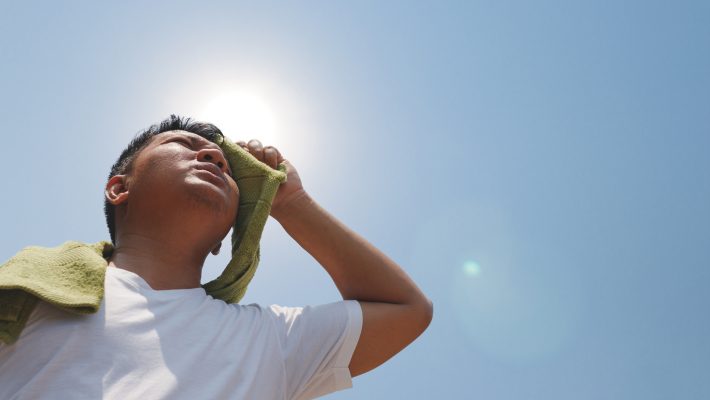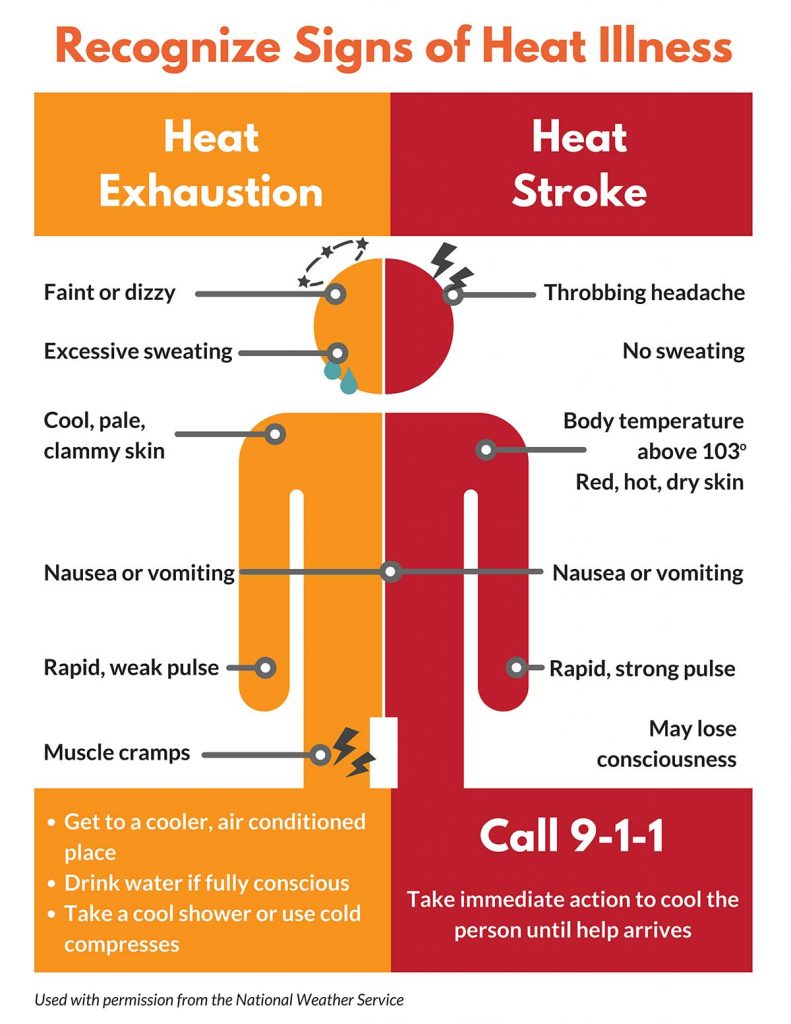
Heat-Related Illnesses
People suffer heat-related illness when their bodies are unable to compensate and properly cool themselves. The body normally cools itself by sweating. But under some conditions, sweating just isn’t enough. In such cases, a person’s body temperature rises rapidly. Very high body temperatures may damage the brain or other vital organs.
Who’s at Risk?
Everyone! Although anyone can potentially be at risk during our summer heat season, children, the elderly and animals are extremely susceptible to heat illnesses.
Other high-risk persons include:
- Our Homeless Population
- People Who Are Ill and/or on Certain Medications
- People Misusing Substances
- Those Who Are Overweight
- Those Who Work Outdoors (Adults and Young Adults)
Heat Stroke
About Heat Stroke
Heatstroke is the most serious heat-related illness. It occurs when the body becomes unable to control its temperature. The body’s temperature rises rapidly, the sweating mechanism fails, and the body is unable to cool down. Body temperature may rise to 106°F or higher within 10 to 15 minutes. Heatstroke can cause death or permanent disability if emergency treatment is not provided.
Warning Signs
Warning signs of heatstroke vary but may include the following:
- An Extremely High Body Temperature (Above 103°F)
- Confusion
- Dizziness
- Nausea
- Rapid, Strong Pulse
- Red, Hot and Dry Skin (No Sweating)
- Throbbing Headache
- Unconsciousness
What to Do
If you see any of these signs, you may be dealing with a life-threatening emergency. Have someone call for immediate medical assistance while you begin cooling the victim. Do the following:
- Get the victim to a shady area.
- Cool the victim rapidly, using whatever methods you can. For example, immerse the victim in a tub of cool water; place the person in a cool shower; spray the victim with cool water from a garden hose; sponge the person with cool water; or if the humidity is low, wrap the victim in a cool, wet sheet and fan him or her vigorously.
- Monitor body temperature and continue cooling efforts until the body temperature drops to 101-102°F.
- If emergency medical personnel are delayed, call the hospital emergency room for further instructions.
- Do not give the victim alcohol to drink.
- Get medical assistance as soon as possible.
Heat Exhaustion
About Heat Exhaustion
Heat exhaustion is a milder form of heat-related illness that can develop after several days of exposure to high temperatures and inadequate or unbalanced replacement of fluids. Those most prone to heat exhaustion are elderly people, those with high blood pressure, and those working or exercising in a hot environment.
Warning Signs
Warning signs of heat exhaustion vary but may include the following:
- Heavy sweating
- Paleness
- Muscle cramps
- Tiredness
- Weakness
- Dizziness
- Headache
- Nausea or vomiting
- Fainting
The skin may be cool and moist. The pulse rate will be fast and weak, and breathing will be fast and shallow. If heat exhaustion is untreated, it may progress to heatstroke. See medical attention if symptoms worsen or last longer than one hour.
What to Do
- Drink cool, nonalcoholic beverages.
- Rest.
- Take a cool shower, bath, or sponge bath.
- Seek an air-conditioned environment.
- Wear lightweight clothing.
Heat Cramps
About Heat Cramps
Heat cramps are muscle pains or spasms – usually in the abdomen, arms, or legs – that may occur in association with strenuous activity. People who sweat a lot during strenuous activity are prone to heat cramps. This sweating depletes the body’s salt and moisture. The low salt level in the muscles causes painful cramps. Heat cramps may also be a symptom of heat exhaustion. If you have heart problems or are on a low-sodium diet, seek medical attention for heat cramps.
What to Do
If medical attention is not necessary, take the following steps:
- Stop all activity and sit quietly in a cool place.
- Drink clear juice or a sports beverage.
- Do not return to strenuous activity for a few hours after the cramps subside because further exertion may lead to heat exhaustion or heat stroke.
- Seek medical attention for heat cramps if they do not subside in 1 hour.
Heat Rash
About Heat Rash
Heat rash is a skin irritation caused by excessive sweating during hot, humid weather. It can occur at any age but is most common in young children. Heat rash looks like a red cluster of pimples or small blisters. It is more likely to occur on the neck and upper chest, in the groin, under the breasts, and in elbow creases.
Treatment for Heat Rash
The best treatment for heat rash is to provide a cooler, less humid environment. Keep the affected area dry. Dusting powder may be used to increase comfort.


